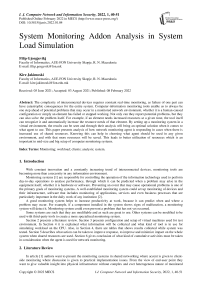System Monitoring Addon Analysis in System Load Simulation
Автор: Filip Gjorgjevikj, Kire Jakimoski
Журнал: International Journal of Computer Network and Information Security @ijcnis
Статья в выпуске: 1 vol.14, 2022 года.
Бесплатный доступ
The complexity of interconnected devices requires constant real-time monitoring, as failure of one part can have catastrophic consequences for the entire system. Computer-information monitoring tools enable us to always be one step ahead of potential problems that may occur in a monitored network environment, whether it is a human-caused configuration or simply an element has failed or stopped working. Not only can they report potential problems, but they can also solve the problem itself. For example, if an element needs increased resources at a given time, the tool itself can recognize it and automatically increase the resource needs of that element. By setting up a monitoring system in a virtual environment, the results can be seen and through their analysis will bring an optimal solution when it comes to what agent to use. This paper presents analysis of how network monitoring agent is responding in cases when there is increased use of shared resources. Knowing this can help in choosing what agent should be used in any given environment, and with that more resources will be saved. This leads to better utilization of resources which is an important in mid-size and big setup of computer monitoring systems.
Monitoring, workload, clients, analysis, system
Короткий адрес: https://sciup.org/15018258
IDR: 15018258 | DOI: 10.5815/ijcnis.2022.01.04
Список литературы System Monitoring Addon Analysis in System Load Simulation
- Savić, M., Ljubojević, M. and Gajin, S., 2020. A Novel Approach to Client-Side Monitoring of Shared Infrastructures. IEEE Access, 8, pp.44175-44189.
- Luchian, E., Docolin, P. and Dobrota, V., 2016, October. Advanced monitoring of the OpenStack NFV infrastructure: A Nagios approach using SNMP. In 2016 12th IEEE International Symposium on Electronics and Telecommunications (ISETC) (pp. 51-54). IEEE.
- Nurwijayanti. KN, Rhekaz Eka Adhytyas, " Garbage Bin Monitoring System Based on the Internet of Things at University Dirgantara Marsekal Suryadarma", International Journal of Education and Management Engineering (IJEME), Vol.11, No.2, pp. 1-12, 2021. DOI: 10.5815/ijeme.2021.02.01
- Kajol R, Akshay Kashyap K, Keerthan Kumar T G," Automated Agricultural Field Analysis and Monitoring System Using IOT", International Journal of Information Engineering and Electronic Business(IJIEEB), Vol.10, No.2, pp. 17-24, 2018. DOI: 10.5815/ijieeb.2018.02.03
- Nalinsak Gnotthivongsa, Huangdongjun, Khamla Non Alinsavath, " Real-time Corresponding and Safety System to Monitor Home Appliances based on the Internet of Things Technology", International Journal of Modern Education and Computer Science(IJMECS), Vol.12, No.2, pp. 1-9, 2020.DOI: 10.5815/ijmecs.2020.02.01
- Renita, J. and Elizabeth, N.E., 2017, March. Network's server monitoring and analysis using Nagios. In 2017 International Conference on Wireless Communications, Signal Processing and Networking (WiSPNET) (pp. 1904-1909). IEEE.
- Mohammad Zubair Khan, " Hybrid Ensemble Learning Technique for Software Defect Prediction ", International Journal of Modern Education and Computer Science(IJMECS), Vol.12, No.1, pp. 1-10, 2020.DOI: 10.5815/ijmecs.2020.01.01
- Rushba Javed, Sidra Anwar, Khadija Bibi, M. Usman Ashraf, Samia Siddique, "Prediction and Monitoring Agents using Weblogs for improved Disaster Recovery in Cloud", International Journal of Information Technology and Computer Science(IJITCS), Vol.11, No.4, pp.9-17, 2019. DOI: 10.5815/ijitcs.2019.04.02
- Umair Ali, Shabib Aftab, Ahmed Iqbal, Zahid Nawaz, Muhammad Salman Bashir, Muhammad Anwaar Saeed, " Software Defect Prediction Using Variant based Ensemble Learning and Feature Selection Techniques", International Journal of Modern Education and Computer Science(IJMECS), Vol.12, No.5, pp. 29-40, 2020.DOI: 10.5815/ijmecs.2020.05.03
- Kocjan, W. and Beltowski, P., 2016. Learning Nagios. Packt Publishing Ltd..
- Maas, M., Andersen, D.G., Isard, M., Javanmard, M.M., McKinley, K.S. and Raffel, C., 2020, March. Learning-based memory allocation for C++ server workloads. In Proceedings of the Twenty-Fifth International Conference on Architectural Support for Programming Languages and Operating Systems (pp. 541-556).
- Garima Rastogi, Rama Sushil,"Performance Analysis of Live and Offline VM Migration Using KVM", International Journal of Modern Education and Computer Science(IJMECS), Vol.8, No.11, pp.50-57, 2016.DOI: 10.5815/ijmecs.2016.11.07
- Fahreza, F. and Rifqi, M., 2020. Nagios Core Optimization By Utilizing Telegram as Notification of Disturbance. Journal of Applied Science, Engineering, Technology, and Education, 2(2), pp.121-135.
- Pei, Z. and Xiaoman, W., 2016. SSD performance analysis and RAID 0 scheme design. Microcomputer & Its Applications.
- Bruschi, G. and Ribeiro, L., 2017. Monitoramento de Serviços de Redes usando SNMP com Nagios e WhatsUp Gold. Caderno de Estudos Tecnológicos, 5(1).
- Enterprises, N., 2017. Nagios.
- Cardoso, A., Teixeira, C.J.V. and Pinto, J.S., 2018. Architecture for highly configurable dashboards for operations monitoring and support. Stud. Inform. Control, 27(3), pp.319-330.
- Wang, J., Park, D., Kee, Y.S., Papakonstantinou, Y. and Swanson, S., 2016, June. Ssd in-storage computing for list intersection. In Proceedings of the 12th International Workshop on Data Management on New Hardware pp. 1-7.
- Baek, S.H. and Park, K.W., 2020. A Durable Hybrid RAM Disk with a Rapid Resilience for Sustainable IoT Devices. Sensors, 20(8), p.2159.
- Scott, N.,2011. “Nagios Conference 2011 - Nagios Performance Tuning”, pp.11.
- Enterprises Nagios,2016, N. Tuning Nagios For Maximum Performance.


